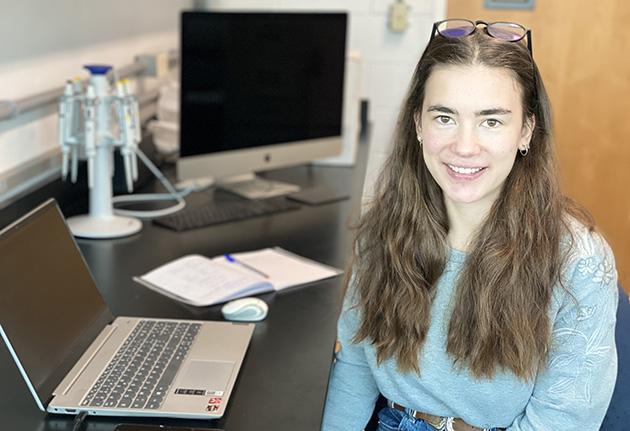Posted in:
New Faces in the “Zoop Group”

BIOS faculty members Leocadio Blanco-Bercial and Amy Maas study tiny zooplankton, essential to the marine food web, and fondly refer to students and researchers in their Bermuda lab as members of their “Zoop Group.” Three new student members have joined their ranks, including two who will complete their internships in the months ahead and another who will continue their work through mid-2022.
Yuuki Niimi, 25, is a graduate student from Arizona State University (ASU) completing his PhD through a collaborative National Science Foundation grant with Blanco-Bercial and Maas.
Niimi, who arrived in Bermuda in June 2021 for at least a year of research at BIOS, completed his undergraduate research in marine biology at the University of Hawaii at Manoa.
He grew up on the coastline of San Francisco and spent summers visiting family in Narita, Japan. After finishing his master’s degree at the University of Southampton in England, he noted a posting at ASU with the opportunity to pursue PhD-level research at BIOS.

His current research involves studying the different roles of zooplankton in the biological carbon pump, which transports carbon from the surface to the deeper parts of the ocean. This movement of carbon from surface to deep ocean can influence carbon dioxide levels in the atmosphere. As planktonic life and their waste products sink below the mixed upper water column, this draws carbon away from exchanges with the air and traps the decaying marine life in deeper parts of the ocean.
Many zooplankton, including copepods and krill, play a direct role in the biological pump through an additional pathway because they can migrate from the surface waters at night, where they feed, to darker depths in the day to avoid predators. This results in waste products being delivered directly to depth during the daytime. Other species, however, remain at depth and do not migrate. Consequently, their activities influence both the sinking carbon and the migrating organisms as they actively feed on both of these food sources.
After collecting samples, Niimi and the team create three-dimensional models of the organisms to produce high-quality, high-contrast images of their morphology, or physical forms. Then, they combine the images with genetic data to identify the animals by species. Combining these data with studies of the vertical distribution of the migrators in the Sargasso Sea helps the researchers identify the specific locations of each species, determine which animals are migrating to what depths, and identify their roles in the movement of carbon through the water column.

Margaux Perhirin, 22, is completing the second (and last) year of her marine science master’s degree from Sorbonne University in Paris, a course of study that includes her current internship at BIOS. “I wanted to study marine sciences for a long time, probably before high school, since I was raised next to the sea in Bretagne, in France,” she said. “My bachelor’s degree was oriented towards marine sciences since it was in a marine station just a few meters from the sea. And the ocean is also attractive because of all the things that we still don’t understand, even if that statement is a little bit cliché.”
Last year, she completed a separate internship supervised by Blanco-Bercial and his research collaborator, biological oceanographer Sakina-Dorothée Ayata from the Laboratory of Oceanography of Villefranche in France. There, Perhirin analyzed copepod images in samples coming from BIOS.
Perhirin arrived in January to work with Blanco-Bercial and Maas, where she is finalizing a large seasonal image and molecular dataset of zooplankton that were collected in the Sargasso Sea in 2016 and 2017. The images can then be used to cluster the diverse zooplankton community by their morphology. Next, this information can be related to the role, or function, they play in the ecosystem, as species with similar life histories tend to converge to a common shape.
This is a novel technique for describing biodiversity in complex systems, Blanco-Bercial said. Perhirin will also add the community molecular data from the same samples, which provides a deeper assessment of the more classical views of diversity—the number of species and their evolutionary relationships. By combining these two very powerful datasets, the objective of her work is to understand the zooplankton community’s dynamics throughout the year, and its impacts on the ecosystem functioning and biogeochemical cycles.

Rocio Rodriguez Pérez, 25, was born in Argentina, where a high school biology teacher sparked her interest in nature and science. She completed her undergraduate degree in biological science at the Favaloro University in Buenos Aires and is now completing a master’s degree at Vrije University in the Netherlands. At BIOS, she is conducting a research project as part of an internship requirement of her master’s program.
Her research project uses techniques similar to Perhirin’s, but focuses on the effects of temperature, oxygen, salinity, and other environmental influences on copepod communities living in different regions, spanning the open ocean on both coasts of the United States.
For her internship, she is focusing on the ecological and evolutionary trade-offs that influence the vertical distribution and behavior of the two main groups of copepods from each region. The role of these two groups in the food web, and their effect on the biogeochemical cycles, are distinct. Some of the differences can be explained by the different evolutionary history of each group.
She arrived at BIOS in September and plans to finish her research this month, followed by a literature-research internship to finish the master’s program. She plans to continue her studies for a doctorate degree in marine studies.
Tagged: